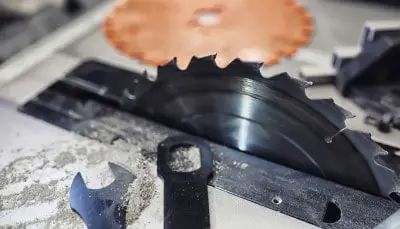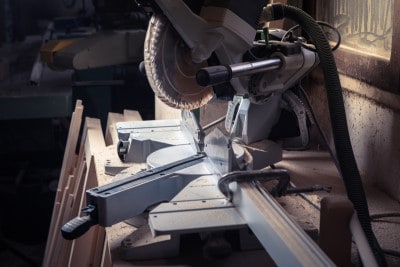A miter saw and a jigsaw are two popular power tools that are commonly used for cutting wood and other materials. While they may seem similar, they have different purposes and capabilities.
Miter saw and jigsaw are two power tools for cutting wood and other materials, with different purposes and capabilities. Miter saw is stationary and designed for precise cuts, while jigsaw is handheld for making curved and irregular cuts. Both have different blades and are used for different tasks such as trim work, molding, cutting curves, and intricate shapes.
In this article, we will compare the miter saw and the jigsaw, highlighting their differences and the best use for each tool.

Miter Saw or Jigsaw, Which is Better for You?
| Feature | Miter Saw | Jigsaw |
|---|---|---|
| Purpose | Precise cross cuts, angled cuts, miter cuts | Curved and irregular cuts, intricate shapes, bevel cuts, plunge cuts |
| Type of tool | Stationary | Handheld |
| Blade | Circular | Reciprocating |
| Cutting capacity | Straight, precise cuts | Curved and irregular cuts |
| Common uses | Trim work, molding, frame cutting | Cutting curves, making plunge cuts, cutting holes, intricate shapes, bevel cuts |
When it comes to making cuts in wood, the two most popular tools are the miter saw and jigsaw. Both of these tools have their own advantages and disadvantages, so it is important to understand which one is best for your project.
The miter saw is an effective tool for creating neat, accurate straight or angled cuts. It can also be used to make more complex cuts such as crown molding or other intricate designs. When you need to make curved cuts, a miter saw will not suffice. That’s when you’ll want to use the jigsaw.
The jigsaw is perfect for making curved cuts and intricate designs that require more finesse than what a miter saw can provide. It has an adjustable blade that allows you to control the depth of your cut and make more precise curves.
Additionally, it has a variety of blades available that can help you create different types of cuts depending on your project needs.
The jigsaw also has a variable speed setting which allows you to adjust the speed according to how thick or thin your material is. With all these features combined, the jigsaw is an invaluable tool when it comes to working with wood.
Miter Saw

The miter saw is a stationary power tool used for making precise cuts in wood and other materials. It consists of a circular blade that is mounted on an arm that pivots to make angle cuts. The arm can be adjusted to make miter cuts, which are angled cuts made at a specific degree.
The miter saw is commonly used for tasks such as trim work, molding, and frame cutting. The blade of a miter saw can be rotated to make cuts at different angles, allowing the user to make precise cross cuts, angled cuts, and miter cuts with ease.
The miter saw is a versatile tool that is essential for any woodworker, carpenter, or DIY enthusiast who needs to make precise cuts in a variety of materials.
Uses
Cross cuts:
- Adjust the miter saw to 0 degrees.
- Place the material to be cut against the fence of the miter saw, with one end touching the blade.
Angle cuts:
- Adjust the miter saw to the desired angle, either to the left or right.
- Place the material to be cut against the fence of the miter saw, with one end touching the blade.
Miter cuts:
- Adjust the miter saw to the desired degree using the miter scale.
- Place the material to be cut against the fence of the miter saw, with one end touching the blade.
Bevel cuts:
- Adjust the miter saw to the desired bevel angle using the bevel scale.
- Place the material to be cut against the fence of the miter saw, with one end touching the blade.
Compound cuts:
- Adjust the miter saw to the desired miter angle using the miter scale.
- Adjust the bevel angle to the desired degree using the bevel scale.
- Place the material to be cut against the fence of the miter saw, with one end touching the blade.
Advantages
A miter saw is a versatile and accurate tool that offers several advantages, including:
- Precision: The ability to make precise cuts at specific angles and degrees makes the miter saw ideal for tasks such as trim work, molding, and frame cutting.
- Speed: The miter saw is a fast and efficient tool, making it possible to complete projects in a fraction of the time it would take to make the same cuts using other tools.
- Versatility: The miter saw is capable of making a variety of cuts, including cross cuts, angle cuts, miter cuts, bevel cuts, and compound cuts, making it a versatile tool for any woodworking project.
- Safety: The miter saw is equipped with safety features such as a blade guard that helps to prevent accidents, making it a safe tool to use.
- Ease of use: The miter saw is designed for ease of use, with features such as a miter scale and bevel scale that make it easy to make precise cuts.
Disadvantages
A miter saw has many advantages, it also has some disadvantages, including:
- Stationary nature: Because the miter saw is a stationary tool, it is not as portable as other power tools such as a jigsaw or circular saw. This can make it difficult to use on job sites or in areas with limited space.
- Limited cutting capacity: While the miter saw is capable of making precise cuts, it is limited in its cutting capacity. The size of the blade and the limited cutting depth can make it difficult to make large cuts or cuts in thicker materials.
- Cost: Miter saws can be more expensive than other power tools, such as a jigsaw or circular saw. This can make it difficult for some DIY enthusiasts or hobbyists to purchase one.
- Dust management: The miter saw can generate a large amount of sawdust, which can be difficult to manage. This can be a problem in enclosed spaces or when working indoors.
- Learning curve: While the miter saw is designed for ease of use, it does have a learning curve. It can take some time to master the different cuts and adjustments, and to become proficient in using the tool.
jigsaw

A jigsaw is a handheld power tool that is used for making curved and irregular cuts in wood and other materials. It consists of a reciprocating blade that moves up and down to cut through the material. The blade is held in place by a clamp that can be adjusted to make cuts at different angles.
Jigsaws are versatile tools that are used for tasks such as cutting curves, making plunge cuts, and cutting holes. They are also commonly used for cutting intricate shapes and making bevel cuts.
The jigsaw is a versatile tool that is easy to use and maneuver, making it ideal for a variety of cutting tasks. The ability to make curved and irregular cuts, combined with its portability and ease of use, make the jigsaw a popular tool for DIY enthusiasts, woodworkers, and carpenters.
The jigsaw is also equipped with several safety features, such as a safety switch, that help to prevent accidents and ensure safe operation.
Uses
Straight cuts:
- Adjust the blade to the desired angle.
- Turn on the jigsaw and begin cutting along the line, using a steady and controlled motion.
Curved cuts:
- Adjust the blade to the desired angle.
- Turn on the jigsaw and begin cutting along the curved line, using a steady and controlled motion.
Plunge cuts:
- Adjust the blade to the desired angle.
- Turn on the jigsaw and carefully lower the blade into the material, making sure to keep the blade perpendicular to the surface.
- Begin cutting along the line, using a steady and controlled motion.
Intricate shapes:
- Adjust the blade to the desired angle.
- Turn on the jigsaw and begin cutting along the intricate shape, using a steady and controlled motion.
Bevel cuts:
- Adjust the blade to the desired angle.
- Turn on the jigsaw and begin cutting along the line, using a steady and controlled motion.
Advantages
A jigsaw is a versatile and portable tool that offers several advantages, including:
- Portability: Because the jigsaw is handheld, it is portable and easy to use on job sites or in areas with limited space.
- Versatility: The jigsaw is capable of making a variety of cuts, including straight cuts, curved cuts, plunge cuts, intricate shapes, and bevel cuts, making it a versatile tool for any woodworking project.
- Ease of use: The jigsaw is designed for ease of use, with features such as an adjustable blade and a comfortable grip that make it easy to use and maneuver.
- Speed: The jigsaw is a fast and efficient tool, making it possible to complete projects in a fraction of the time it would take to make the same cuts using other tools.
- Cost: Jigsaws are generally less expensive than other power tools, such as a miter saw, making it an affordable option for DIY enthusiasts or hobbyists.
Disadvantages
While a jigsaw has many advantages, it also has some disadvantages, including:
- Accuracy: Because the jigsaw is handheld, it may not be as accurate as a stationary tool such as a miter saw. This can make it difficult to make precise cuts, especially when working on large or heavy pieces of material.
- Cutting capacity: The cutting capacity of a jigsaw is limited by the size of the blade and the power of the motor. This can make it difficult to make large cuts or cuts in thicker materials.
- Dust management: The jigsaw can generate a large amount of sawdust, which can be difficult to manage. This can be a problem in enclosed spaces or when working indoors.
- Vibration: Because the jigsaw is handheld, it can be difficult to control, and the vibration can cause fatigue during extended use.
- Safety: While the jigsaw is equipped with safety features, it is still a handheld power tool that can pose a safety risk if not used properly.
Conclusion
Both the miter saw and jigsaw are essential tools for any woodworking project.
The miter saw is a stationary tool that is capable of making precise cuts at specific angles and degrees, making it ideal for tasks such as trim work, molding, and frame cutting. However, its stationary nature, limited cutting capacity, and cost can be disadvantages.
The jigsaw, on the other hand, is a handheld tool that is portable and easy to use, making it ideal for a variety of cutting tasks. However, its accuracy, limited cutting capacity, dust management, vibration, and safety concerns can be disadvantages.
Both tools have their advantages and disadvantages, and it is important to carefully consider the needs of your project and your skill level before choosing between the two.








